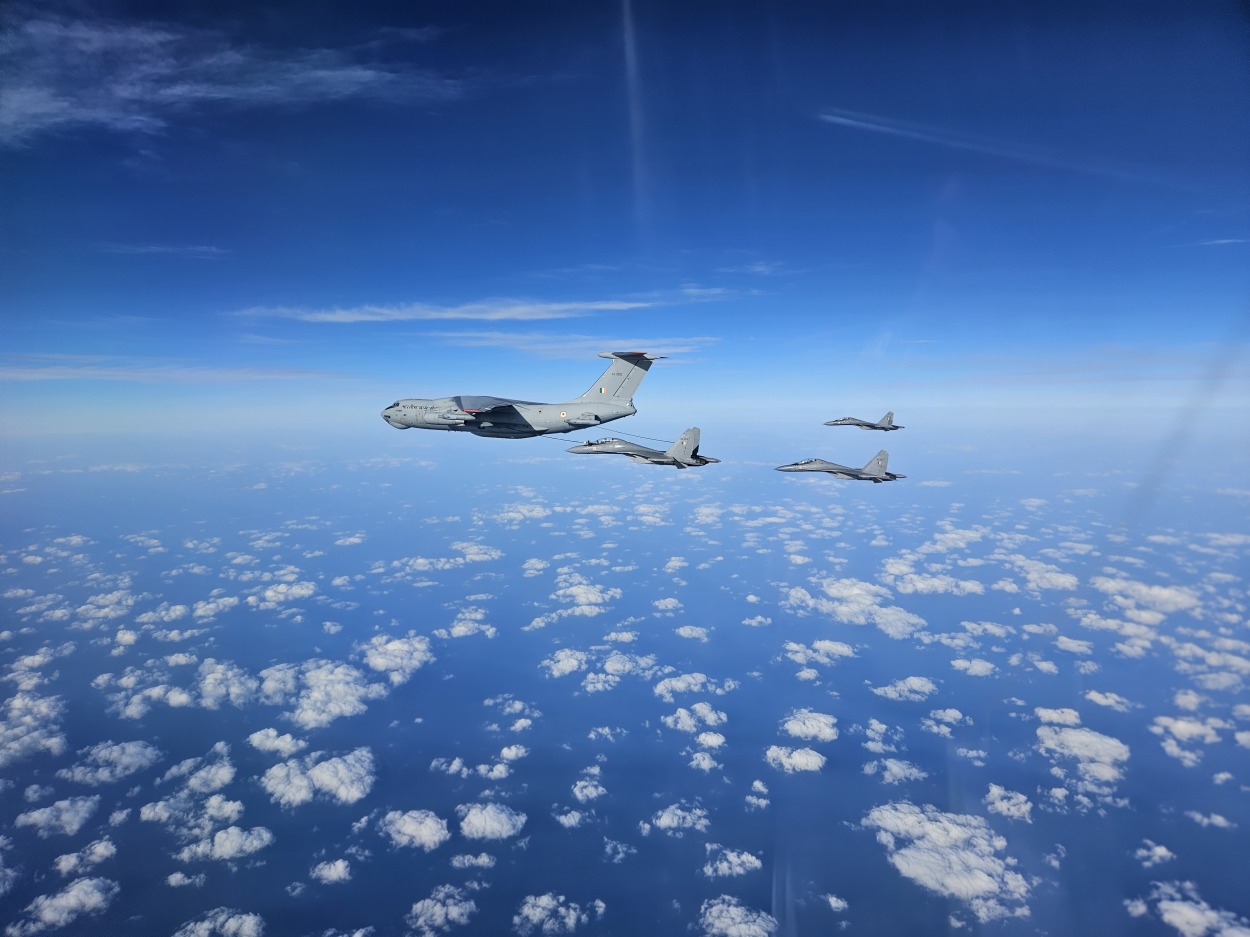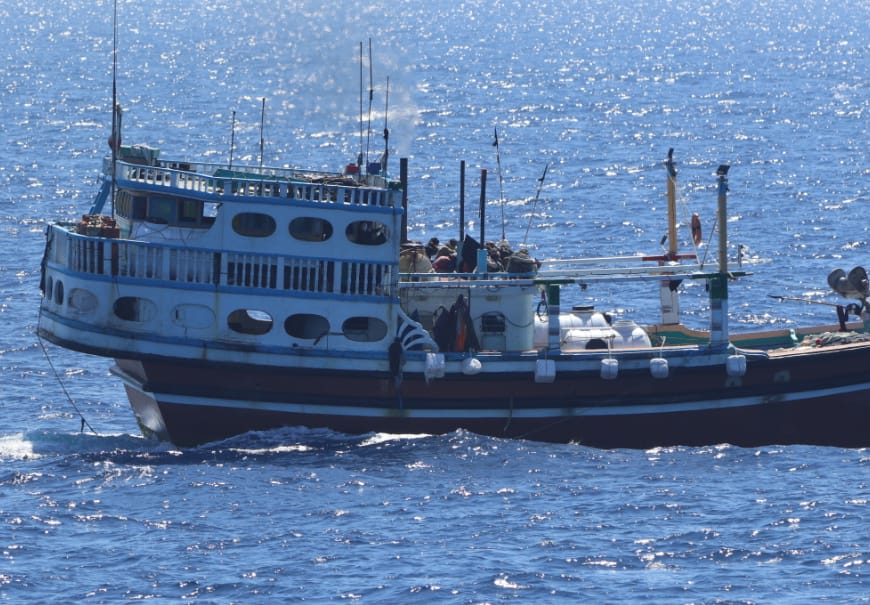India is consciously building its military interoperability with West Asian nations to expand its strategic reach in the Indian Ocean Region.
India is engaging with the militaries of West Asian nations in what seems to be a sense of urgency in building its strong ties with their militaries, even as the conflicts engulf the region.
India sees an opening in the region, even as the US and China vie with each other to build on their influence. Among the nations India is engaging militarily, apart from Israel, are the United Arab Emirates (UAE), Saudi Arabia, and Oman.
There has been some defense-related interaction at different levels with all these nations in recent days, indicating a conscious bid by India to get entrenched in West Asia and expand its influence there.
Exercise Desert Knight Air Force Engagement
The most profound of these engagements has been the Exercise Desert Knight, in which India joined the United Arab Emirates and France in showcasing its out-of-area air force operations.

On January 23, the Indian Air Force (IAF) conducted Exercise Desert Knight along with the French Air and Space Force (FASF) and the United Arab Emirates (UAE) Air Force.
While the French participation included the Rafale fighter aircraft and a multi-role tanker transport, the UAE Air Force fielded the F-16. These aircraft operated from the Al Dhafra air base in the UAE.
The IAF contingent comprised Su-30 MKI, MiG-29, Jaguar fighter jets, Airborne Warning and Control System aircraft, C-130-J special operations aircraft, and a mid-air refueller aircraft.
The exercise in the Indian Flight Information Region (FIR) was conducted over the Arabian Sea, with IAF aircraft operating from bases within India.
Exercise Desert Knight’s main focus was enhancing synergy and interoperability between the three Air Forces. “The interactions during the exercise facilitated the exchange of operational knowledge, experiences, and best practices amongst the participants,” an IAF spokesperson said.
“Such exercises indicate the growing diplomatic and military interactions in the region, apart from showcasing the prowess of the IAF,” the spokesperson said.
India’s Strategic Reach In The Region
But what was left unsaid was that Exercise Desert Knight enabled India to showcase its strategic reach to interdict hostiles with its combat, cargo, and mid-air refueling aircraft in an increasingly volatile region.
The Arabian Sea, which is part of the Indian Ocean Region that India has always viewed as its backyard and itself as the regional net security provider, has witnessed the spilling over of the West Asian armed conflict, posing a threat to shipping lanes in the Arabian Sea with drone and missile attacks on commercial vessels.
The region has also faced piracy attacks on cargo vessels, and the Indian Navy has been the first responder to incidents of attacks by both pirates and Houthi rebels, either to rescue the crew members of commercial ships or to ward off pirates.
On January 26, responding to the distress call from MV Marlin Luanda, the Indian Navy’s destroyer warship INS Visakhapatnam provided a fire-fighting team of 10 personnel. It doused the fire after battling for six hours. A US and French warship also responded to the distress call.
On January 28, another Indian warship, INS Sumitra, was on Anti-Piracy Operations along the east coast of Somalia & the Gulf of Aden when it responded to the hijacking of an Iranian-flagged Fishing Vessel (FV) Iman. Pirates had boarded the FV & the crew was taken as hostages.

INS Sumitra intercepted the vessel and acted by the established SOPs to coerce the pirates for the safe release of the crew along with the boat. It ensured the successful release of all 17 crew members and the ship. The FV was subsequently sanitized and released for onward transit.
These two are the latest incidents in the Arabian Sea that the Indian Navy responded to, in a series of such interdictions by its warships to either carry out anti-piracy operations or to assist cargo ships hit by drones or missiles.
India’s Defense Secretary In Oman
Meanwhile, India’s Defense Secretary Giridhar Aramane will visit Oman and will be there on January 30 and 31 to co-chair the 12th Joint Military Cooperation Committee meeting with the Oman Ministry of Defence Secretary General Dr Mohammed bin Naseer bin Ali Al-Zaabi.
During the talks, India and Oman will review defense cooperation between the two countries and explore new initiatives like industry collaboration to strengthen bilateral engagements further. The two sides will also exchange views on regional and global issues of shared interest, including the West Asia conflict and the security of the shipping lanes in the Arabian Sea.
“The visit will further consolidate defense cooperation and strategic partnership between the two countries spanning every sphere of military collaboration, such as bilateral exercises, staff talks, and training as well as new and emerging areas, an Indian Ministry of Defense spokesperson said on January 29.
India and Oman have a robust and multifaceted relationship that has expanded into several strategic areas, including defense and security. Both countries are committed to working under the vision of strategic partnership. The two countries have a common interest in peace and prosperity of the entire region.
India, Saudi Arabia Joint Army Exercise
In a first, India and Saudi Arabia launched their joint Military Exercise ‘SADA TANSEEQ’ on January 29 at the Mahajan Test Ranges in Rajasthan. The joint Army Exercise will continue till February 10, according to an Indian Army spokesperson.
Royal Saudi Land Forces represent the Saudi Arabian contingent, comprising 45 personnel. A battalion from the Brigade of the Guards (Mechanised Infantry) forms the Indian Army contingent, comprising 45 personnel.
The Army Exercise aims to train troops of both sides for Joint Operations in Semi-Desert terrain under Chapter VII of the United Nations Charter.
The Exercise will enable both sides to share their best practices in the tactics, techniques, and procedures of conducting operations in the sub-conventional domain. It will facilitate developing interoperability between troops from both sides.
The Exercise will involve establishing a Mobile Vehicle Check Post, Cordon and Search Operation, House Intervention Drill, Reflex Shooting, Slithering, and Sniper Firing.
The Exercise will provide an opportunity for both the contingents to strengthen their bond. The spokesperson said it would be a platform to achieve shared security objectives, enhance defense cooperation, and foster bilateral relations between the two friendly nations.
- NC Bipindra is a 30-year veteran in journalism specializing in strategic affairs, geopolitics, aerospace, defense, and diplomacy. He has written extensively for the Times of India, New Indian Express, Press Trust of India, and Bloomberg News. He can be reached at ncbipindra (at) gmail.com
- Follow EurAsian Times on Google News




